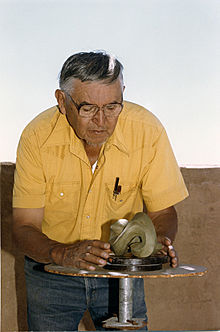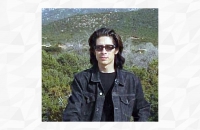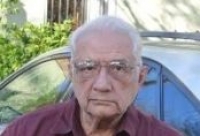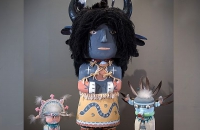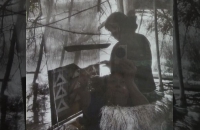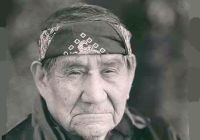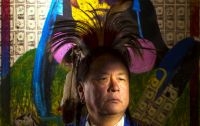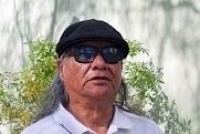ALLAN HOUSER
(Chiricahua Apache b. 1914 – 1994)
“I work with clay and pull it around and see what I can do with experimental forms. When I’m creating something I’m there with the clay, and after a while something begins to build. One of the good things is creating something that you have never seen before.”
Allan Houser, who created many, many things people had never seen before, was born Allan Capron Houser or Ha-oz-ous (June 30, 1914—August 22, 1994). Houser was a Chiricahua Apache sculptor, painter and book illustrator born in Oklahoma. He was one of the most renowned Native American painters and Modernist sculptors of the 20th century.
Houser fused traditional themes with Modernist aesthetics, crafting a unique abstract-figural style. Allan Houser was the first member of his family from the Warm Springs Chiricahua Apache tribe born outside of captivity since Geronimo’s 1886 surrender and the tribe's imprisonment by the U.S. government. The tribe had been led in battle by the legendary spiritual leader Geronimo, who would later rely on his grandnephew Sam Haozous, Allan’s father, to serve as his translator.
In 1934, Houser left Oklahoma at the age of 20 to study at Dorothy Dunn's Art Studio at the Santa Fe Indian School in Santa Fe, New Mexico. Dunn's method encouraged working from personal memory, avoiding techniques of perspective or modeling, and stylization of Native iconography. For the latter, Houser made hundreds of drawings and canvasses in Santa Fe and was one of Dunn's top students, but he found the program too constricting. He concluded his studies there in 1938. It was there that he was encouraged to change his name from Ha-oz-ous to Houser.
“I was twenty years old when I finally decided that I really wanted to paint. I had learned a great deal about my tribal customs from my father and my other, and the more I learned the more I wanted to put it down on canvas. That’s pretty much how I started.”
He created a mural for the Department of Interior Building shortly after studying at the Painting School (part of the Santa Fe Indian School) in the 1930s. A move to Los Angeles during World War II brought
him into contact with the work of other modernist sculptors such as Henry Moore, Constantin Brancusi, Jean Arp, Isamu Noguchi and Barbara Hepworth and other European artists who would later influence his practice.
In 1939, Houser began his professional career by showing work at the 1939 New York World's Fair and the Golden Gate International Exposition. He received his first major public commission to paint murals at the Main Interior Building in Washington, DC. He also married Anna Maria Gallegos of Santa Fe, his wife until his death. The Housers had five sons, two who followed in their father’s footsteps as sculptors.
While Houser's early career was marked by his drawings and paintings, it was for sculpture that he eventually became a world-renowned artist. Beginning in 1940 with simple wood carvings, Houser created his first monumental work in stone in 1949, the iconic piece Comrades in Mourning at the Haskell Institute in Lawrence, Kansas. A year later, he received a Guggenheim Fellowship.
In 1940, he received another commission with the US Department of Interior to paint life-sized indoor murals, then returned to Fort Sill to study with Swedish muralist Olle Nordmark, who encouraged Houser to explore sculpture. He made his first wood carvings that year.
Among his best-known works is the large bronze sculpture Sacred Rain Arrow (1988), which features the flowing organic lines characteristic of Modernist sculpture. Houser died on August 22, 1994 in Santa Fe, NM, two years after being awarded the National Medal for the Arts. In 2004, a retrospective of his work served as the inaugural exhibition for the National Museum of the American Indian.
SELECTED COLLECTIONS:
... Smithsonian Museum of American Art
… the National Museum of the American Indian
… the National Portrait Gallery in Washington, DC.
… numerous major museum collections throughout North America, Europe and Japan
… Offering of the Sacred Pipe is on display at United States Mission to the United Nations in New
York City, New York
About the artist
Allan Houser
ALLAN HOUSER
(Chiricahua Apache b. 1914 – 1994)
“I work with clay and pull it around and see what I can do with experimental forms. When I’m creating something I’m there with the clay, and after a while something begins to build. One of the good things is creating something that you have never seen before.”
Allan Houser, who created many, many things people had never seen before, was born Allan Capron Houser or Ha-oz-ous (June 30, 1914—August 22, 1994). Houser was a Chiricahua Apache sculptor, painter and book illustrator born in Oklahoma. He was one of the most renowned Native American painters and Modernist sculptors of the 20th century.
Houser fused traditional themes with Modernist aesthetics, crafting a unique abstract-figural style. Allan Houser was the first member of his family from the Warm Springs Chiricahua Apache tribe born outside of captivity since Geronimo’s 1886 surrender and the tribe's imprisonment by the U.S. government. The tribe had been led in battle by the legendary spiritual leader Geronimo, who would later rely on his grandnephew Sam Haozous, Allan’s father, to serve as his translator.
In 1934, Houser left Oklahoma at the age of 20 to study at Dorothy Dunn's Art Studio at the Santa Fe Indian School in Santa Fe, New Mexico. Dunn's method encouraged working from personal memory, avoiding techniques of perspective or modeling, and stylization of Native iconography. For the latter, Houser made hundreds of drawings and canvasses in Santa Fe and was one of Dunn's top students, but he found the program too constricting. He concluded his studies there in 1938. It was there that he was encouraged to change his name from Ha-oz-ous to Houser.
“I was twenty years old when I finally decided that I really wanted to paint. I had learned a great deal about my tribal customs from my father and my other, and the more I learned the more I wanted to put it down on canvas. That’s pretty much how I started.”
He created a mural for the Department of Interior Building shortly after studying at the Painting School (part of the Santa Fe Indian School) in the 1930s. A move to Los Angeles during World War II brought
him into contact with the work of other modernist sculptors such as Henry Moore, Constantin Brancusi, Jean Arp, Isamu Noguchi and Barbara Hepworth and other European artists who would later influence his practice.
In 1939, Houser began his professional career by showing work at the 1939 New York World's Fair and the Golden Gate International Exposition. He received his first major public commission to paint murals at the Main Interior Building in Washington, DC. He also married Anna Maria Gallegos of Santa Fe, his wife until his death. The Housers had five sons, two who followed in their father’s footsteps as sculptors.
While Houser's early career was marked by his drawings and paintings, it was for sculpture that he eventually became a world-renowned artist. Beginning in 1940 with simple wood carvings, Houser created his first monumental work in stone in 1949, the iconic piece Comrades in Mourning at the Haskell Institute in Lawrence, Kansas. A year later, he received a Guggenheim Fellowship.
In 1940, he received another commission with the US Department of Interior to paint life-sized indoor murals, then returned to Fort Sill to study with Swedish muralist Olle Nordmark, who encouraged Houser to explore sculpture. He made his first wood carvings that year.
Among his best-known works is the large bronze sculpture Sacred Rain Arrow (1988), which features the flowing organic lines characteristic of Modernist sculpture. Houser died on August 22, 1994 in Santa Fe, NM, two years after being awarded the National Medal for the Arts. In 2004, a retrospective of his work served as the inaugural exhibition for the National Museum of the American Indian.
SELECTED COLLECTIONS:
... Smithsonian Museum of American Art
… the National Museum of the American Indian
… the National Portrait Gallery in Washington, DC.
… numerous major museum collections throughout North America, Europe and Japan
… Offering of the Sacred Pipe is on display at United States Mission to the United Nations in New
York City, New York

